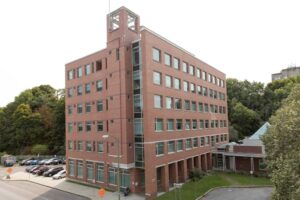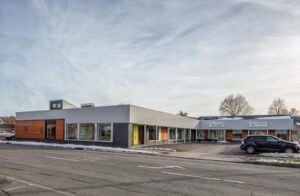County Mental Health Building
Tompkins County launched its ambitious Green Facilities project in 2022, seeking to shrink the carbon footprint of all county buildings. A three-phase  effort, it has focused on improving the energy efficiency of county facilities by updating insulation, lighting, heating, and cooling technologies, while also transitioning away from fossil fuels to the electrification of building systems.
effort, it has focused on improving the energy efficiency of county facilities by updating insulation, lighting, heating, and cooling technologies, while also transitioning away from fossil fuels to the electrification of building systems.
Work on the County Mental Health building at 201 E. Green St. kicked off the first phase of the Green Facilities project. The planning and engineering process, carried out in partnership with Johnson Controls, took months to get to the construction stage and costs rose in the meantime.
But it was exciting to see the physical work get underway. “To me, it’s about being a model,” said Terry Carroll, the County’s Chief Sustainability Officer at the time. “It’s showing what’s possible. These are buildings that are particularly difficult to try and decarbonize.”
Johnson Controls’ Chris Fitzsimmons strongly agreed with Carroll about the potential for establishing a model for similar decarbonization projects.
“It’s super exciting because we’re setting the standard along with a partner that wants to set the standard,” he said. “[It] is going to be such a great facility for us to reference and maybe tour with other municipalities that might want to say, ‘Hey, what are they doing? How can we be a part of it? How can we also get to those goals?’ And that carbon reduction, that public health for upstate New York, that’s the biggest piece of it. So, that facility is going to be visited by me and a lot of people in the next couple of years.”
Upgrades to the heating, ventilation, and air conditioning (HVAC) system were a top priority for the Mental Health building. The natural gas system was replaced with a variable refrigerant flow HVAC system for heating and cooling, along with a new electric re-heat based ventilation system.
In addition to replacing the HVAC system, improvements involved LED lighting, building envelope and weatherization improvements, including insulation, and some controls optimization to better regulate energy usage. Replacing the windows in the next couple of years is also on the to-do list, according to Carroll.
The enthusiasm for carrying out these upgrades was obviously justified once completed. Most notably, the building has significantly improved its energy performance as a result of the recent work. The EUI dropped sharply from 67.1 in 2023 to 45.7 in 2024, and the building has now met the 2030 target for energy. Clearly, the completion of phase one has established a strong foundation for the County’s work in the next two phases.


 Currently a mixed-use building with retail on the first floor and three apartments above, 104 East State St. dates back to the late 1860s and once operated as a clothing store. Today, the building houses Homegrown Skateshop, the only skateboarder-run retail business serving Ithaca.
Currently a mixed-use building with retail on the first floor and three apartments above, 104 East State St. dates back to the late 1860s and once operated as a clothing store. Today, the building houses Homegrown Skateshop, the only skateboarder-run retail business serving Ithaca. An icon of the Finger Lakes region, Purity Ice Cream was first founded in 1936. As a popular destination for ice cream lovers, the Purity building located at 700 Cascadilla St. houses a mix of restaurant, retail, and office space.
An icon of the Finger Lakes region, Purity Ice Cream was first founded in 1936. As a popular destination for ice cream lovers, the Purity building located at 700 Cascadilla St. houses a mix of restaurant, retail, and office space. John Guttridge, along with his business partner David Kuckuk, has forged an innovative path on the west side of the Commons,
John Guttridge, along with his business partner David Kuckuk, has forged an innovative path on the west side of the Commons, The flagship store of the GreenStar Food Co-op opened at its new location in May 2020 as a model of environmental stewardship. From the beginning GreenStar has sought to support regional farmers and producers, and provide its customers with as many local products as it can. Currently, local products make up more than 25% of its sales. Now the Co-op has a building to match its commitment to sustainable foods.
The flagship store of the GreenStar Food Co-op opened at its new location in May 2020 as a model of environmental stewardship. From the beginning GreenStar has sought to support regional farmers and producers, and provide its customers with as many local products as it can. Currently, local products make up more than 25% of its sales. Now the Co-op has a building to match its commitment to sustainable foods.
 building owners John Guttridge and his partner David Kuko at Urban Core, LLC, they have produced an exceptional example of the magic created when every detail of what it means to run a socially and environmentally responsible business receives careful consideration.
building owners John Guttridge and his partner David Kuko at Urban Core, LLC, they have produced an exceptional example of the magic created when every detail of what it means to run a socially and environmentally responsible business receives careful consideration. e heart of Ithaca. A LEED (Leadership In Energy And Environmental Design) certified building, the inn is an outstanding example of how historic preservation and green design can be combined to produce a beautiful, high performing building that exudes personality and character.
e heart of Ithaca. A LEED (Leadership In Energy And Environmental Design) certified building, the inn is an outstanding example of how historic preservation and green design can be combined to produce a beautiful, high performing building that exudes personality and character.
 effort, it has focused on improving the energy efficiency of county facilities by updating insulation, lighting, heating, and cooling technologies, while also transitioning away from fossil fuels to the electrification of building systems.
effort, it has focused on improving the energy efficiency of county facilities by updating insulation, lighting, heating, and cooling technologies, while also transitioning away from fossil fuels to the electrification of building systems.